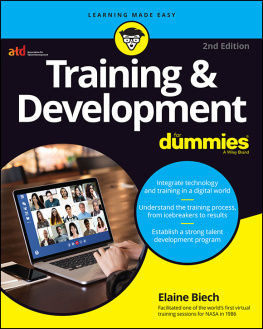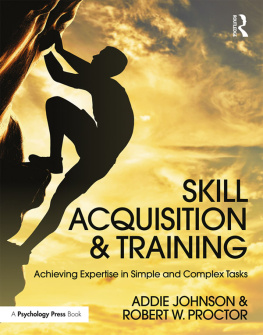

2018 ASTD DBA the Association for Talent Development (ATD)
All rights reserved. Printed in the United States of America.
21 20 19 18 1 2 3 4 5
No part of this publication may be reproduced, distributed, or transmitted in any form or by any means, including photocopying, recording, information storage and retrieval systems, or other electronic or mechanical methods, without the prior written permission of the publisher, except in the case of brief quotations embodied in critical reviews and certain other noncommercial uses permitted by copyright law. For permission requests, please go to www.copyright.com, or contact Copyright Clearance Center (CCC), 222 Rosewood Drive, Danvers, MA 01923 (telephone: 978.750.8400; fax: 978.646.8600).
ATD Press is an internationally renowned source of insightful and practical information on talent development, training, and professional development.
ATD Press
1640 King Street
Alexandria, VA 22314 USA
Ordering information: Books published by ATD Press can be purchased by visiting ATDs website at www.td.org/books or by calling 800.628.2783 or 703.683.8100.
Library of Congress Control Number: 2018942808
ISBN-10: 1-947308-54-8
ISBN-13: 978-1-947308-54-1
e-ISBN: 978-1-947308-55-8
ATD Press Editorial Staff
Director: Kristine Luecker
Manager: Melissa Jones
Community of Practice Manager, Learning & Development: Amanda Smith
Developmental Editor: Jack Harlow
Associate Editor: Caroline Coppel
Text Design: Iris Sanchez
Cover Design: Faceout Studio, Spencer Fuller
Printed by Versa Press Inc., East Peoria, IL
Preface: Waldingers Journey
The old saying is that necessity is the mother of invention, and The Waldinger Corporation would have to agree. It was because of a significant business need that the company took the chance of stepping into largely uncharted training territory in search of an effective solution. The gamble paid off; the company launched a program that rapidly took on a life of its own. That program, and the concept that built it, is the reason this book now exists.
Lets start with a bit of history, to set the stage properly.
Harry Waldinger immigrated to the United States in his mid-20s. At the age of 30, this Austrian-born tinsmith founded our company in 1906. From the start, the company focused on building both a strong reputation and overall growth. Harry passed away in 1935, leaving his two sons to run the four-employee company. In 1940, they took a bold step by bidding on a job 10 times larger than they had ever attempted before. The risk paid off when the project was successfully completed and the company stepped into bigger and bigger projects.
The Waldinger Corporation continues to grow. It is now a full-service sheet metal, mechanical, and electrical contractor with a reputation built on projects in 42 states. Waldinger currently employs more than 2,000 professionals and exceeds annual revenues of $400 million. The company plans to continue to grow to become a billion-dollar company within the next few years. Exciting as that may be, pursuing, achieving, and sustaining that level of growth requires expansions in many areas within the company.
But who has time to expand parts of the company from within if everyone is focused on doing the actual work supporting the ability to expand? It can be a catch-22 that ultimately stifles the ability to grow. Of course, this is where workplace talent development professionals come in. While there has always been a great deal of informal training taking place, it has only been in the most recent decade that the company explored the idea of having full-time dedicated staff members to provide training.
Initially, Waldinger employed trainers who worked to provide training as requested to various areas within the company. However, the company lacked a comprehensive curriculum and an ability to strategically coordinate training to achieve key business results. Training that did take place was isolated, resulting in disconnected and duplicated efforts.
Waldinger strives for excellence and efficiency in its project work. Leadership knew that they had areas for improvement in how they were approaching the training function, as well as how the training function could better support the company. So in more recent years, Waldinger changed the expectations of its training and development department. Its members went from being company-wide order takers to strategic resources whose efforts would focus on tasks with the greatest level of impact upon the business. The companys structured on-the-job training (SOJT) efforts, and everything that spawned from the initial task, have flourished ever since.
The Need
When the company set its eyes on becoming a billion-dollar companyits strategy was entitled Plan B (for billion)it also sought to identify potential obstacles to getting there. One quickly identified major factor was a lack of competent project managers to lead the project work the company would take on. Any individual project manager could only manage so many smaller or medium size projects at one time, and large projects almost always required a project manager to be assigned to that project and nothing else.
One way for the company to grow was to bid for larger and larger projects, just as Harry Waldingers sons did in 1940 to grow the business. But a lack of project managers to take on those roles could prevent the company from growing at the rate that it sought to.
The most common way for someone to become a project manager at Waldinger was to be hired straight out of college with a degree in engineering or a similar subject. These individuals started as project engineers, and they would begin their path to learning on how to be a project manager at Waldinger. Their education would consist of some classroom-type training internally, participation in third-party training sessions, trade association events, and OJT.
Most of a project engineers learning took place while they served under the wing of an experienced project manager. They worked on an actual project, often spending most of their time on the job site. This truly is the best venue to learn to be a project manager, because so much of the project managers duties are more art than science at times. Basic details of the job could be taught in a classroom, but the nuances and subtleties of the types of decisions a project manager needs to be able to make must be experienced in real-life situations to fully learn them.
But this experience-based learning lacked consistency. One project engineer might have a dramatically different experience from another based on a variety of factors: the type of job they were assigned to, the nature of the work they were assigned to do, and how much time their mentor project manager devoted to helping them truly learn. While some project managers would seriously seek to guide their project engineer through stretch goals, others might simply assign them the paperwork that they themselves preferred not to do.
Such inconsistencies within the largest portion of the project engineers learning, combined with the rather haphazard approach to exposing them to other forms of training, meant it took quite a bit of time for most project engineers to develop the level of knowledge, skill, and competency that would pave the way for their promotion to project manager. This process could take about five to seven years from when a project engineer started with Waldinger, until they were deemed to be a competent project manager who could oversee a multimillion-dollar job.
Next page















